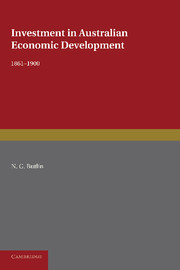Book contents
- Frontmatter
- Contents
- LIST OF TABLES
- LIST OF TEXT-FIGURES
- LIST OF PLATES
- Preface
- PART A INTRODUCTION
- PART B THE PRIVATE SECTOR
- CHAPTER II INVESTMENT IN RURAL DEVELOPMENT
- CHAPTER III INVESTMENT IN URBANISATION I: URBANISATION AND INDUSTRIAL DEVELOPMENT
- CHAPTER IV INVESTMENT IN URBANISATION II: THE GROWTH OF RESIDENTIAL REAL ESTATE
- PART C THE PUBLIC SECTOR
- PART D STRUCTURAL READJUSTMENT
- Appendix I Revision of N.S.W. Residential Investment 1905/06-1911/12
- Appendix II Australian Domestic Product, Investment and Foreign Borrowing, 1861-1938/39.
- Bibliography
- Index
CHAPTER II - INVESTMENT IN RURAL DEVELOPMENT
from PART B - THE PRIVATE SECTOR
Published online by Cambridge University Press: 05 June 2016
- Frontmatter
- Contents
- LIST OF TABLES
- LIST OF TEXT-FIGURES
- LIST OF PLATES
- Preface
- PART A INTRODUCTION
- PART B THE PRIVATE SECTOR
- CHAPTER II INVESTMENT IN RURAL DEVELOPMENT
- CHAPTER III INVESTMENT IN URBANISATION I: URBANISATION AND INDUSTRIAL DEVELOPMENT
- CHAPTER IV INVESTMENT IN URBANISATION II: THE GROWTH OF RESIDENTIAL REAL ESTATE
- PART C THE PUBLIC SECTOR
- PART D STRUCTURAL READJUSTMENT
- Appendix I Revision of N.S.W. Residential Investment 1905/06-1911/12
- Appendix II Australian Domestic Product, Investment and Foreign Borrowing, 1861-1938/39.
- Bibliography
- Index
Summary
INTRODUCTION
The second half of the nineteenth century has a special interest in the development of the Australian rural economy in that this was the period when an experimental utilisation of the eastern Australian continent as a whole was attempted, following the pioneering occupation of much of the area before 1850. The key of this experiment lay in the establishment of the heavily capitalised and equipped pastoral station and the extension of Australian flock-carrying capacity, even if only briefly, to a level, in 1892, which was significantly exceeded only by the middle of the twentieth century. It is unfortunate that a verdict of T. A. Coghlan, in 1900, on the gains from fencing, based on and, indeed, a paraphrase of the views of the N.S.W. chief inspector of stock twenty years earlier should have persisted in subsequent literature in unbalanced form. As a result of fencing, ‘… the country will carry onethird more sheep; the wool will be longer and sounder and the fleece as a whole one-third better; the feed will be cleaner… and the sheep continue longer profitable; they will be freer from foot-rot and other diseases; the expense of working the station will be less than a quarter of what it would be if the sheep were shepherded; and finally the owner will be able to devote the principal part of his time to improving his sheep, instead of spending it in attempting to manage a number of shepherds and hutkeepers. It has also been found that the percentage of lambing is higher among paddocked than shepherded sheep.’
Pastoral capital formation, with its accompanying changes in technique, was the central factor in the growth of rural productivity, affecting flock-carrying capacity, fleece yields and labour productivity. But uncritical acceptance of Coghlan's verdict has encouraged writers to disregard the place of water conservation in the growth of pastoral estates and of rural productivity, to interpret the motivation of pastoralists in terms of the hindsight of an expert and to ignore the fact that the chief inspector of stock was, originally, summarising strictly physical results, not judging the economic or social implications of investment for a station, the industry or the economy.
- Type
- Chapter
- Information
- Investment in Australian Economic Development, 1861–1900 , pp. 57 - 180Publisher: Cambridge University PressPrint publication year: 2013



